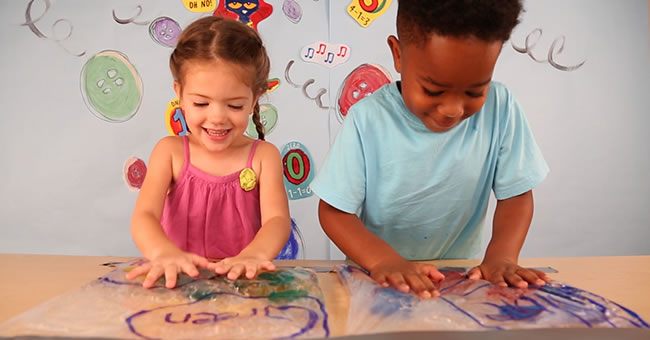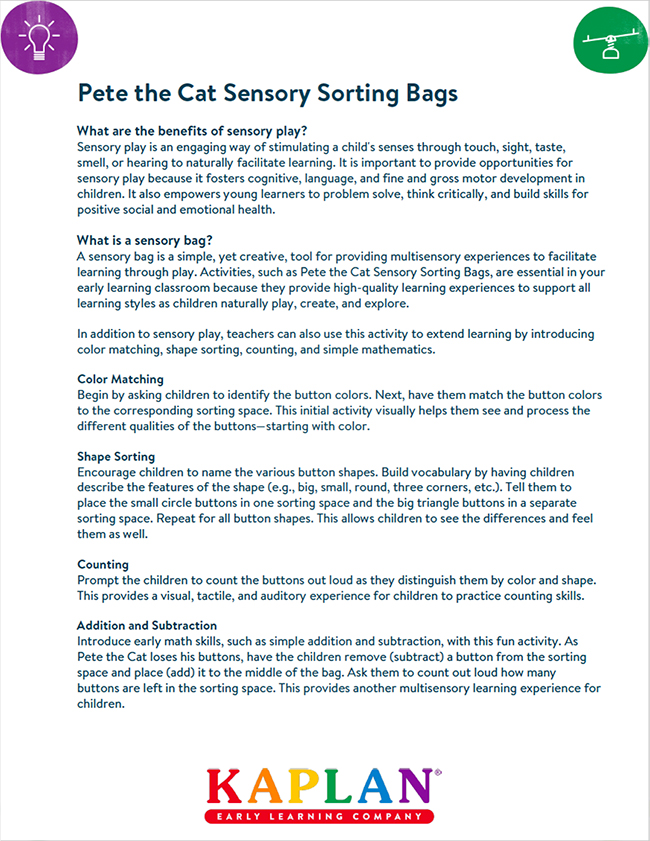
Transform sensory play into a groovy activity of discovery and fun with Pete the Cat DIY sensory bags. Inspired by Pete the Cat and His Four Groovy Buttons, teachers can include this activity within small groups to encourage hands-on exploration and introduce early math concepts to children three years and up. Young learners will be excited to squish, sort, and count as they sing along with the book.
What are the benefits of sensory play?
Sensory play is an engaging way of stimulating a child's senses through touch, sight, taste, smell, or hearing to naturally facilitate learning. It is important to provide opportunities for sensory play because it fosters cognitive, language, and fine and gross motor development in children. It also empowers young learners to problem solve, think critically, and build skills for positive social and emotional health.
What is a sensory bag?
A sensory bag is a simple, yet creative, tool for providing multisensory experiences to facilitate learning through play. Activities, such as Pete the Cat Sensory Sorting Bags, are essential in your early learning classroom because they provide high-quality learning experiences to support all learning styles as children naturally play, create, and explore.
In addition to sensory play, teachers can also use this activity to extend learning by introducing color matching, shape sorting, counting, and simple mathematics.
Color Matching
Begin by asking children to identify the button colors. Next, have them match the button colors to the corresponding sorting space. This initial activity visually helps them see and process the different qualities of the buttons—starting with color.
Shape Sorting
Encourage children to name the various button shapes. Build vocabulary by having children describe the features of the shape (e.g., big, small, round, three corners, etc.). Tell them to place the small circle buttons in one sorting space and the big triangle buttons in a separate sorting space. Repeat for all button shapes. This allows children to see the differences and feel them as well.
Counting
Prompt the children to count the buttons out loud as they distinguish them by color and shape. This provides a visual, tactile, and auditory experience for children to practice counting skills.
Addition and Subtraction
Introduce early math skills, such as simple addition and subtraction, with this fun activity. As Pete the Cat loses his buttons, have the children remove (subtract) a button from the sorting space and place (add) it to the middle of the bag. Ask them to count out loud how many buttons are left in the sorting space. This provides another multisensory learning experience for children.
Download our FREE printable below!

Required Materials:
- Gallon Ziploc® Bag
- Hair Gel (Colored or Clear)
- Permanent Marker
- Really Big Buttons
- Clear Large Buttons
- Duct Tape
- Small Mixing Container
Optional Materials:
- Pete the Cat and His Four Groovy Buttons (Hardback)
- Four Groovy Buttons Felt Set
- Pete the Cat® Backpack and Lunchbag
- Pete the Cat Vowel Sound Readers
- Pete the Cat Doll and 4 Paperback Book Set
1Label
Using a permanent marker, label the bag with colors, numbers, or shapes that you would like to have the child sort out. Draw a circle around it to create a sorting space.
2Fill the Bag
Fill the large Ziploc® bag ¾ full of hair gel (we got our gel from a dollar store).
3Add Buttons
Place a variety of buttons, making sure to use colors and shapes that match your sorting labels.
4Seal and Secure
Using duct tape, seal the edges of the bag. Tape the bag to a table for easier sorting play (optional).
Include the Pete the Cat Sensory Bags activity in your classroom to provide creative opportunities for multi-sensory experiences.
Be sure to browse our list of sensory-related products, resources, and professional development.
